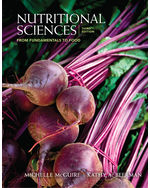Description
Test Bank For Nutritional Sciences From Fundamentals to Food 3rd Edition By Michelle Shelley
Chapter 4 – Carbohydrates
Multiple Choice
Answer, level, page Level: K = knowledge, A = application/critical thinking
What Are Simple Carbohydrates? (pp. 115-121)
c K 115 1. Simple carbohydrates include monosaccharides and _____.
a. amylose
b. amylopectin
c. disaccharides
d. pectins
d K 115 2. The most abundant monosaccharides found in food include glucose, _____, and _____.
a. lactose, fructose
b. sucrose, maltose
c. sucrose, lactose
d. fructose, galactose
a K 115 3. Which of the following is a simple carbohydrate?
a. Galactose
b. Amylose
c. Raffinose
d. Glycogen
a K 115 4. Which monosaccaride is often called “blood sugar” and is the most abundant sugar in our bodies?
a. Glucose
b. Fructose
c. Galactose
d. Sucrose
c K 116 5. What is the primary function of glucose?
a. To facilitate synthesis of some amino acids
b. To provide a ready source of glycosidic bonds
c. To provide a source of energy to cells
d. To facilitate synthesis of glycogen
b K 115 6. Monosaccharides have 6 carbon atoms and are called _____ sugars.
a. pentose
b. hexose
c. xylose
d. ribose
a K 117 7. Which monosaccharide is the most abundant “sugar” in fruits and vegetables?
a. Fructose
b. Glucose
c. Maltose
d. Galactose
b K 117 8. High-fructose corn syrup (HFCS) is derived from corn and consists of almost equal amounts of:
a. fructose and galactose.
b. fructose and glucose.
c. glucose and maltose.
d. glucose and galactose.
d K 117 9. What foods represent the most significant sources of fructose in the typical U.S. diet?
a. Honey and fruits
b. Fruits and vegetables
c. Fruit drinks and fruit beverages
d. Foods and beverages sweetened with HFCS
d K 118 10. What is the major food source of galactose?
a. Fruit
b. Whole grains
c. Vegetables
d. Milk
d K 117 11. Which monosaccharide is the preferred energy source for the nervous system and the sole source for the red blood cells?
a. Sucrose
b. Fructose
c. Galactose
d. Glucose
c K 117 12. What is the consumption of high-fructose corn syrup (in pounds per year per person) by Americans estimated by the USDA?
a. 12
b. 22
c. 35
d. 44
c K 117 13. Currently, high-fructose corn syrup accounts for what percentage of the total energy intake in the U.S.?
a. 3%
b. 5%
c. 7%
d. 9%
b K 119 14. Disaccharides are formed when two monosaccharides are bonded together as a result of a _____ reaction.
a. hydrolysis
b. condensation
c. glycosidic
d. synthesis
a K 119 15. Sucrose, maltose, and lactose all include the monosaccharide:
a. glucose.
b. fructose.
c. galactose.
d. raffinose.
a K 120 16. What determines whether a carbohydrate is digestible or indigestible?
a. The type of glycosidic bond
b. The amount of carbohydrate eaten at the same time
c. Whether or not the food is cooked
d. Whether or not the food contains monosaccharides
a K 122 17. Which of the following artificial sweeteners contains phenylalanine and thus poses a potential risk to people who have the genetic condition phenylketonuria?
a. Equal®
b. Sugar Twin®
c. Sweet One®
d. Splenda®

Reviews
There are no reviews yet.